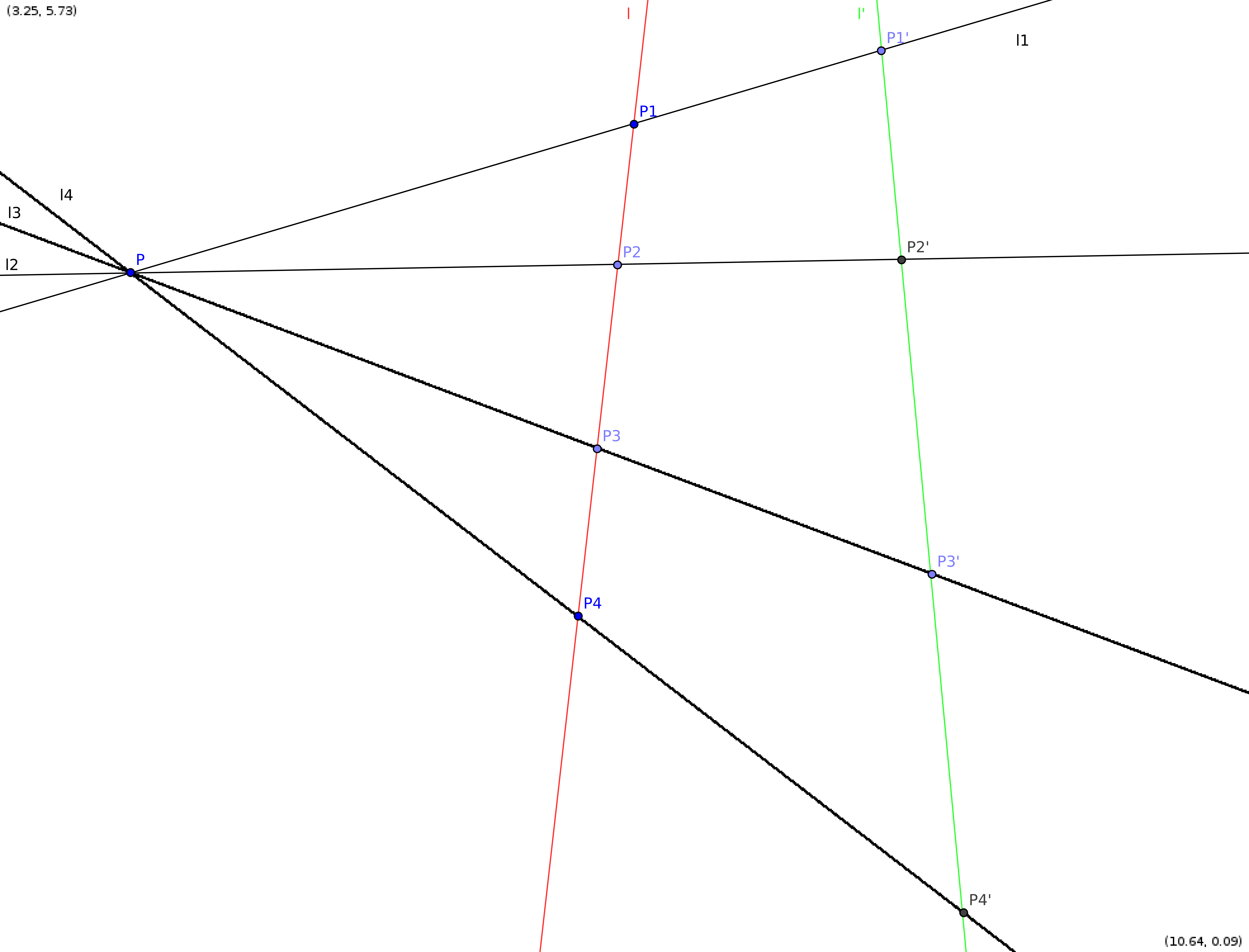Cross-ratio (Doppelverhältnis)
We are looking for invariants with respect to projective transformations.
Definition: Let $ P_{i} =[v_i]= \ssqvector{x_{i} \\ y_{i}}$, $i=1,\ldots,4$, be four distinct points on a projective line $ \RP^{1} $. Then the cross-ratio of these points is
\begin{align*}
cr(P_{1},P_{2},P_{3},P_{4})
&= \frac{\det(v_1v_2)}{\det(v_2v_3)}\frac{\det(v_3v_4)}{\det(v_4v_1)}\\
&= \dfrac{x_{1}y_{2}-x_{2}y_{1}}{x_{2}y_{3}-x_{3}y_{2}} \dfrac{x_{3}y_{4}-x_{4}y_{3}}{x_{4}y_{1}-x_{1}y_{4}}.\\
\end{align*}
If $y_{i} \neq 0$, we may introduce affine coordinates $ u_{i} = \frac{x_{i}}{y_{i}}$. This yields
\begin{align*}
cr(P_{1},P_{2},P_{3},P_{4}) =
&= \dfrac{y_{1}y_{2}( \frac{x_{1}}{y_{1}}-\frac{x_{2}}{y_{2}} ) }{y_{2}y_{3}( \frac{x_{2}}{y_{2}}-\frac{x_{3}}{y_{3}} )} \dfrac{y_{3}y_{4}( \frac{x_{3}}{y_{3}}-\frac{x_{4}}{y_{4}} ) }{y_{4}y_{1}( \frac{x_{4}}{y_{4}}-\frac{x_{1}}{y_{1}} )} \\
&= \dfrac{u_{1}-u_{2}}{u_{2}-u_{3}} \dfrac{u_{3}-u_{4}}{u_{4}-u_{1}}\,.
\end{align*}
If for example $y_{1}=0 $ (hence $u_{1}= \infty $), then
\[
cr(P_{1},P_{2},P_{3},P_{4}) =
\dfrac{\infty-u_{2}}{u_{2}-u_{3}} \dfrac{u_{3}-u_{4}}{u_{4}-\infty} =
– \dfrac{u_{3}-u_{4}}{u_{2}-u_{3}}\,.
\]
Cancelling $ \infty $ yields the correct result, since
\begin{align*}
cr(P_{1},P_{2},P_{3},P_{4})
&= \dfrac{x_{1}y_{2}(x_{3}y_{4}-x_{4}y_{3})}{(x_{2}y_{3}-x_{3}y_{2})(-x_{1}y_{4})} \\
&= \dfrac{x_{1}y_{2}y_{3}y_{4}(u_{3}-u_{4})}{-x_{1}y_{2}y_{3}y_{4}(u_{2}-u_{3})}
= – \dfrac{(u_{3}-u_{4})}{u_{2}-u_{3}}\,.
\end{align*}
Lemma: The cross-ratio of four distinct points in $\RP^{1} $ does not depend on the choice of basis (i.e. on the choice of homogeneous coordinates).
Proof. Let $ P_{i} = \left[\begin{pmatrix} \tilde{x}_{i} \\ \tilde{y}_{i} \end{pmatrix}\right]$ with $ \begin{pmatrix}\tilde{x}_{i} \\ \tilde{y}_{i} \end{pmatrix} = A \begin{pmatrix} x_{i} \\ y_{i} \end{pmatrix} $ for some $ A \in \mathrm{GL}(2, \mathbb{R}) $. Then the cross-ratio of these points is given by
\begin{align*}
cr(P_{1},P_{2},P_{3},P_{4}) &=
\dfrac{
\det
\begin{pmatrix}
\tilde{x}_{1} & \tilde{x}_{2} \\
\tilde{y}_{1} & \tilde{y}_{2}
\end{pmatrix}
\det\begin{pmatrix}
\tilde x_3&\tilde x_4\\
\tilde y_3&\tilde y_4
\end{pmatrix} }{
\det\begin{pmatrix}
\tilde x_2&\tilde x_3\\
\tilde y_2&\tilde y_3
\end{pmatrix}
\det
\begin{pmatrix}
\tilde x_4&\tilde x_1\\
\tilde y_4&\tilde y_1
\end{pmatrix}} \\
&=
\dfrac{
\det
\left(A
\begin{pmatrix}x_{1} & x_{2} \\ y_{1} & y_{2} \end{pmatrix}
\right)
\det
\left(A
\begin{pmatrix}x_3&x_4\\y_3&y_4\end{pmatrix}
\right) }{
\det
\left(A
\begin{pmatrix}x_2&x_3\\y_2&y_3\end{pmatrix}
\right)
\det
\left(A
\begin{pmatrix}x_4&x_1\\y_4&y_1\end{pmatrix}
\right)} \\
&=
\dfrac{
\det\begin{pmatrix}x_{1} & x_{2} \\ y_{1} & y_{2} \end{pmatrix} \det\begin{pmatrix}x_3&x_4\\y_3&y_4\end{pmatrix} }{
\det\begin{pmatrix}x_2&x_3\\y_2&y_3\end{pmatrix}\det\begin{pmatrix}x_4&x_1\\y_4&y_1\end{pmatrix}}\,.
\end{align*}
Corollary. If $ f\colon \RP^{1} \to\RP^{1} $ is a projective transformation, then
\[cr(P_{1},P_{2},P_{3},P_{4}) = cr(f(P_{1}),f(P_{2}),f(P_{3}),f(P_{4}))\]
for pairwise distinct $ P_{i} \in \RP^{1} $.
Proof: As above, $ f([v]) = [Av] $ with $ A \in GL(n, \mathbb{R}) $.
Theorem: Projective transformations map projective lines to projective lines and preserve cross-ratios for arbitrary four distinct points mapped from one projective line to another.
Proof:
- Linear isomorphisms map 2-dim subspaces to 2-dim subspaces and hence projective transformations map projetive lines to projective lines.
- If we restrict the projective transformation to a line (i.e. we restrict the linear isomorphism to a $2$-dimensional subspace) we obtain a projective transformation on the projective line and we can use the above lemma and corollary.
□
Defintion. Let $ \ell_{1}$, $\ell_{2}$, $\ell_{3}$, $\ell_{4} $ be four concurrent lines ($\ell_{1}\cap\ell_{2}\cap \ell_{3}\cap \ell_{4} = P$) in $ \RP^{2} $ that are distinct. Then the cross-ratio of the four lines is
\[cr(\ell_{1},\ell_{2},\ell_{3},\ell_{4}) = cr(P_{1},P_{2},P_{3},P_{4})\,,\]
where $\ell$ is a projective line with $ P \notin \ell $ and $ P_{i} = \ell_{i} \cap \ell$.
The cross-ratio does not depend on the line $\ell$ because the intersection points of two distinct lines with the lines $\ell_i$ are related by a central projection that does not affect the cross-ratio of the points.
Proposition: Let $P_{1}$, $P_{2}$, $P_{3}$, $P_{4}$ be four distinct points on a projective line and $ f\colon \RP^{1} \to\RP^{1} $ a projective transformation, that maps $P_{2}$, $P_{3}$, $P_{4}$ to points with affine coordinates $0$, $1$, $\infty$, respectively. Then the affine coordinate of $f(P_{1})$ is $ cr(P_{1},P_{2},P_{3},P_{4}) $.
Proof: Let $q_{1}$ be the affine coordinate of $f(P_{1})$. then
\begin{align*}q_{1} = \dfrac{q_{1}-0}{0-1}\dfrac{1-\infty}{\infty-q_{1}} &= cr(q_{1},0,1,\infty) \\
&= cr(f(P_{1}),f(P_{2}),f(P_{3}),f(P_{4}))
= cr(P_{1},P_{2},P_{3},P_{4})\,.\end{align*}
Remark: The cross-ratio of four distinct points is never $ 0$, $1$ or $\infty$.
Proposition: Let $P_{1}$, $P_{2}$, $P_{3}$, $P_{4}$ and $Q_{1}$, $Q_{2}$, $Q_{3}$, $Q_{4}$ be two sets of distinct points on a projective line (or two projective lines). Then there exists a projective transformation $ f\colon \RP^{1} \to\RP^{1} $ with $f(P_{i}) = Q_{i}$ if and only if $cr(P_{1},P_{2},P_{3},P_{4}) = cr(Q_{1},Q_{2},Q_{3},Q_{4})$.
Proof: ” $\Rightarrow$” projective transformations preserve cross-ratios.
” $\Leftarrow$” Let $ f\colon \RP^{1} \rightarrow \RP^{1} $ be a projective transformation with $f(P_{2}) = Q_{2}$, $f(P_{3}) = Q_{3}$ and $f(P_{4}) = Q_{4}$. Then $f(P_{1})= \tilde{Q}_{1}$. Show $Q_{1} = \tilde{Q}_{1} $. We have
\[cr(P_{1},P_{2},P_{3},P_{4}) = cr(f(P_{1}),f(P_{2}),f(P_{3}),f(P_{4})) = cr(\tilde{Q}_{1},Q_{2},Q_{3},Q_{4})\,.\]
But that implies
\begin{equation}
cr(\tilde{Q}_{1},Q_{2},Q_{3},Q_{4}) = cr(Q_{1},Q_{2},Q_{3},Q_{4})\,.\label{ProofCR}
\end{equation}
If we introduce coordinates
\[Q_{2}=\left[\begin{pmatrix} 0 \\ 1 \end{pmatrix}\right]\,,\ Q_{3}=\left[\begin{pmatrix} 1 \\ 1 \end{pmatrix}\right]\,,\ Q_{4}=\left[\begin{pmatrix} 1 \\ 0 \end{pmatrix}\right]\]
and
\[Q_{1}=\left[\begin{pmatrix} q_{1} \\ 1 \end{pmatrix}\right]\,,\ \tilde{Q}_{1}=\left[\begin{pmatrix} \tilde{q}_{1} \\ 1 \end{pmatrix}\right]\,,\]
from \eqref{ProofCR} we obtain $q_{1} = \tilde{q}_{1} $. This implies $Q_{1} = \tilde{Q}_{1}$.
The cross-ratio depends on the order of the points!
\[cr(P_{1},P_{2},P_{3},P_{4}) = \dfrac{u_{1}-u_{2}}{u_{2}-u_{3}} \dfrac{u_{3}-u_{4}}{u_{4}-u_{1}}\,.\]
The value of the cross-ratio does not change, if we swap two distinct pairs of points:
\[cr(P_{1},P_{2},P_{3},P_{4}) = cr(P_{2},P_{1},P_{4},P_{3}) = cr(P_{3},P_{4},P_{1},P_{2}) = cr(P_{4},P_{3},P_{2},P_{1})\]
From the 24 permutations of the two points we only need to calculate the cross-ratio for permutations of the last three entries:
- $ cr(P_{1},P_{2},P_{3},P_{4}) = cr(q,0,1, \infty) =q $,
- $ cr(P_{1},P_{2},P_{4},P_{3}) = cr(q,0, \infty, 1) = \frac{q}{q-1}$,
- $ cr(P_{1},P_{3},P_{2},P_{4}) = cr(q,1,0, \infty) = 1-q $,
- $ cr(P_{1},P_{3},P_{4},P_{2}) = cr(q,1,\infty,0) = \frac{q-1}{q} $,
- $ cr(P_{1},P_{2},P_{3},P_{4}) = cr(q, \infty, 0,1) = \frac{1}{1-q} $ and
- $ cr(P_{1},P_{2},P_{3},P_{4}) = cr(q, \infty,1,0) = \frac{1}{q} $.

